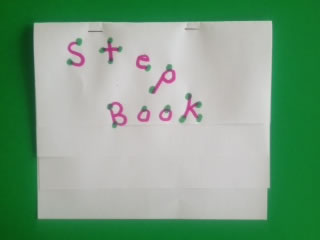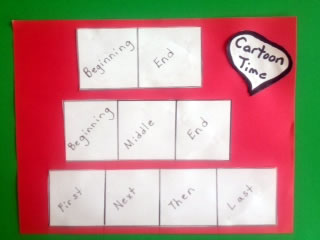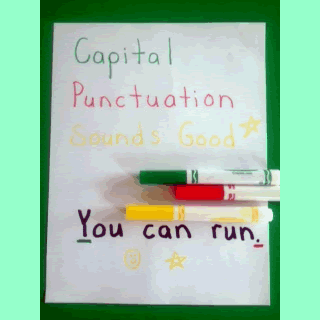August, 2014
“Center”ed around the Core
Ready or not, the new school year is just around the corner! Last month I shared center ideas for reading literature and reading foundations. This month you’ll find ideas for writing, language, and math. Think of these activities as “seeds” that you can plant all year long. “Harvest” them and make them work for your curriculum, standards, and your students.
A teacher recently referred to July as “summer prep” time. So I wish you all very merry summer prepping!
W.K.1 I can write, draw, and tell my opinion.
Predictable Books
Fold two sheets of paper in half. Make little tears about a thumbnail apart down the folded edge. Fold the tabs forward and backwards to make your book. Use it to make the following books:
I Like I Don’t Like
I Wish I Want
Love Is… Happiness Is…
Scary Things Things That Bug Me
•Remind children to use as many colors as they are in age when they make their books.
Hint! Vary book making with markers, crayons, colored pencils, and other materials.

Thank You Notes
Fold a sheet of paper in fourths and you’re ready to write a thank you note to parent volunteers, school helpers, etc.
•Use these to make birthday cards, get well cards, etc.

I Like…
Ask children to cut out a picture of something they like from a catalog and write about it.
Why do you like it?
W.K.2 I can write, draw, and tell to teach.

Nature Walk
Prepare a worksheet with the following sentences:
I see…
I hear…
I smell…
I feel…
Put worksheets on a clipboard and take children on a nature walk. Have them fill in the blanks and illustrate their observations.
Picture Talk
Let children look through a magazine or newspaper and find an interesting picture. Have them cut it out, glue it to a sheet of paper, and then write about it.
How To Step Book
Take two sheets of paper and place the top sheet about 1”  below the bottom sheet. Fold backwards and adjust to make four layers or “steps.” Staple at the top. Children can use these to write/draw:
below the bottom sheet. Fold backwards and adjust to make four layers or “steps.” Staple at the top. Children can use these to write/draw:
How to build a snowman
How to make a peanut butter sandwich
How to be a buddy
Life cycle
Seasons

Brochure
Fold a sheet of paper into a burrito and flatten to make a brochure. Use these to make a brochure of a field trip, your school, your city, your state, a science or social studies theme, etc.
Touch and Tell
You will need two pairs of socks, paper, pencils, and small unusual items (Scruffy, dry dog food, hair bow, baby toy, bubble wrap, seasonal object, etc.) Place a small object in each sock. Children choose a sock, feel it, and then write a description (or draw) what they think is in the sock.
Hint! Use one sock for younger children. Number socks for older students so they can write down what they think is in each sock.
Make and Write
Give children play dough and ask them to make something that relates to a unit of study. Can they write three things about it?
W.K.3 I can write, draw, and say what happened to tell a story.
 Cartoons
Cartoons
Prepare cartoon frames with two, three, and four sections.
1st - Begin with two frames and ask children to draw/write in the frames what happens to them at the beginning of the day and the end of the day.
•Let them use the two frames to draw/write what happened in the beginning and end of a book that was read.
2nd – Ask children to draw/write what happens at the beginning, middle, and end of their day.
•Use three frames to recall the beginning, middle, and end of a story.
3rd – Encourage children to create original stories with four frames. *Demonstrate how to make dialog bubbles to make their cartoon characters talk.
Time Line
Cut paper in half lengthwise to make strips. Draw a line horizontally down the middle. Have children draw what they were like as a baby on the left side. Can they draw what they look like now in the middle? Draw what they think they will look like when they grow up on the right end.
•Use the time line to recall the sequence of a story, the life cycle of a seed, and so forth.
What Will Happen Next?
Let children cut a picture out of a magazine or newspaper. Can they write a story about what they think will happen next?
W.K.5 I can edit my work to make it better.

Green, Red, Yellow
After children write a sentence tell them to underline the capital letter with a green crayon or marker. Underline the punctuation at the end with a red crayon or marker.
If they read their sentence, and it sounds good, they can use the yellow marker to give it a smile  or a star
or a star .
.
W.K.6 I can use technology to publish my work.
Pick and Type
Place a sand pail next to the computer. At the beginning of the year write alphabet letters on index cards. Children choose a card, find it on the keyboard, and type it. As the year goes along use high frequency words instead of letters for pick and type.

Ipads for All
Place the keyboard for your electronic device on the copy machine and make a color copy. Glue it to the inside of a pocket folder. Write letters, numerals, words, etc. on index cards and place them in the pocket. Children choose a card and type it on the keyboard.
Next Page



 below the bottom sheet. Fold backwards and adjust to make four layers or “steps.” Staple at the top. Children can use these to write/draw:
below the bottom sheet. Fold backwards and adjust to make four layers or “steps.” Staple at the top. Children can use these to write/draw: Cartoons
Cartoons




